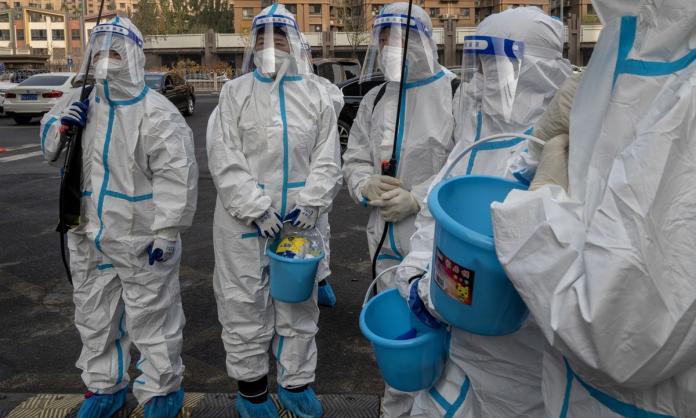A surge in both COVID-19 cases and protests inside China presents a dilemma for the ruling Communist Party.
The regime has long adopted a successful strategy of eliminating the virus. Unlike in the United States, where a “profits before people” political framework often dominated, resulting in more than 1 million fatalities, China’s policy has averted mass death. Despite having four times the population of the US, China has reported just more than 5,000 fatalities.
“Even allowing for propagandistic understatement of the Chinese numbers, Xi’s China has clearly been far more successful in protecting its population from the worst effects of the virus than any country in the West”, historian Adam Tooze noted last week. “As a result, it cannot be stated too often, China’s life expectancy overtook that in the United States in 2021, a truly historic marker.”
Yet three years into the pandemic, China appears ill prepared to deal with its most serious outbreak yet. According to OECD data, the country has fewer than four ICU beds per 100,000 people—compared to 9.4 in Australia and 34 in Germany—and a nurse-to-population ratio that is perhaps one-fifth of the average in developed countries. Its elderly population has a relatively low vaccination rate by international standards and as such is incredibly vulnerable.
The Chinese Communist Party has relied almost totally on lockdowns and an incredibly punitive quarantine system, which is generating increasing resentment that has exploded in street demonstrations and riots in recent weeks.
Beginning in response to a fire in an apartment block in Ürümqi, the capital of Xinjiang, in which at least ten people died—widely blamed on COVID restrictions that lock apartment buildings from the outside and prevent emergency services from accessing those in need—the demonstrations have taken aim at draconian aspects of COVID-19 measures that many believe are failing to protect human lives.
On 25 November, thousands of Han majority demonstrators hit the streets of Ürümqi. Demonstrators surrounded government buildings and demanded justice for the victims of the fire, as well as the relaxation of COVID restrictions to allow greater access to food and essential services. They sang China’s national anthem, with its lyric, “Rise up, those who refuse to be slaves!”
Demonstrations in solidarity with the victims of the Ürümqi fire spread to major cities across the Chinese mainland from 26 to 29 November. In the capital Beijing, at least a thousand people gathered along Beijing’s third ring road, chanting: “We are all Shanghai people! We are all Xinjiang people!”
In Shanghai, youth-led gatherings converged on Middle Ürümqi Road—named after the Xinjiang capital—lighting candles, laying white flowers and holding blank pieces of paper (in reference to state censorship) over their faces and heads (white is the traditional colour of mourning in China). Demonstrators openly criticised the Communist Party and President Xi Jinping, chanting: “Communist Party! Step down! Xi Jinping! Step down!”
Student demonstrations took place at more than 50 university campuses, including a number of elite universities, such as Tsinghua University and Peking University. Video footage shows students singing “The Internationale” and chanting “Freedom will prevail!”
In cities including Lanzhou, Wuhan and Guangzhou, demonstrators clashed with police and destroyed tents and COVID-19 testing booths. Security forces responded by erecting barricades, closing university campuses, deploying pepper spray and carrying out mass arrests. By 30 November, hundreds of government vans, SUVs and armoured vehicles had been stationed in major cities; police and paramilitary forces were conducting citizen ID checks and searching mobile phones, looking for foreign apps, photos of the protests or other evidence that people had taken part; online mentions of the protests were deleted by the regime’s censors.
“There has been nothing like this on this scale and so openly anti-government in China for more than three decades”, Bai Zhi,* a long-time activist, says over the phone from outside the mainland.
“China has had waves of large-scale protests and strikes in the 1990s, 2000s and early 2010s. But these actions have been localised, and protesters tended to avoid criticising the national government. Instead, they blamed local officials or employers in the hope of avoiding repression and persuading the national government to take their side in the disputes. Not since 1989 [Tiananmen Square] have there been protests on a national scale.”
This is because large sections of the population have begun to lose faith in the ability of the regime to handle COVID-19.
During 2020 and 2021, COVID zero was largely successful, with overwhelming public support for the health measures. Over the course of 2022, however, Bai Zhi says a string of incidents have undermined confidence in the strategy: many cities have been in lockdown for months at a time; untold numbers of people have become seriously ill and died after being locked in their homes, unable to access medical care; suicides are on the rise; mandatory tests have become super-spreader events; a bus carrying infected patients to a quarantine facility crashed, killing 27 people; and the “big whites”—public servants and police in white hazmat suits—have gone from national heroes embodying the collective good to impersonal enforcers of brutal policies, who regularly carry out public beatings of individuals.
The consolidation of Xi Jinping’s rule for a historic third term has also stifled any illusions in political change taking place within the CCP. Combined with a slowdown in economic growth, rising youth unemployment (almost 20 percent among those aged between 16 and 24) and diminishing job prospects, the economic uncertainty and pain are being felt by wider sections of the population.
“The majority of people on the streets think that COVID is a threat and needs to be adequately dealt with”, he says. “But they also think that their livelihoods need to be met. The CCP is failing to achieve either.”
To keep industrial profits flowing, the state has instituted a range of inhumane policies. Eli Friedman, writing in the Boston Review, calls it the “closed loop” system, which allows capital to circulate freely while human mobility is reduced to a bare minimum in an effort to contain the virus while maintaining economic growth:
“Closed loop manufacturing requires that workers enter the factory and stay there—eating, sleeping, and working solely within the grounds of the plant ... Meanwhile the work-from-home regime that white collar workers endure is in essence a closed loop organised at the level of the household.”
But many poor and working-class residents of the major cities don’t fit into either of the closed loops, being rural-to-urban migrants prevented from leaving the city to go back to their homes during lockdowns; they are denied access to state provisions such as welfare, food and medicine. These measures have generated forms of resistance among those trapped inside (or outside) the closed loop.
Food riots occurred on the outskirts of Shanghai after migrant workers in informal housing went weeks without either income or state-provided food deliveries. In at least one reported incident, they commandeered a vegetable truck and distributed the goods freely to a gathering crowd.
The most dramatic example of working-class resistance to the closed loop system erupted at the Foxconn iPhone assembly plant on 22 and 23 November. The factory in Henan, the provincial capital of Zhengzhou, employs more than 200,000 workers and accounts for 60 percent of the province’s exports. Workers rioted when the company tried to prevent them from leaving the factory after COVID was detected.
Video footage shows thousands of workers clashing with riot police, breaking through barricades and hurling them at security personnel, before thousands are seen jumping over walls and squeezing between fences to escape to their home towns. Many had to walk for miles along roads and through fields without food or water, surviving thanks to the goodwill of locals who provided them with provisions and shelter.
Zhengzhou was subsequently placed under lockdown in an attempt to quell the rioting; Foxconn was forced to offer 10,000 yuan (approximately US$1,400) and free bus rides to workers who wished to leave the factory and return to their home towns.
“What started as a labour dispute escalated into a riot that caught the attention of the entire country”, says Bai Zhi. “The Foxconn workers demonstrated that if you stand up to the Chinese state and capital, you can win.”
The Communist Party has responded to the wave of protests by lifting some restrictions, such as lockdowns and mandatory PCR testing, while placing the blame on local politicians for the poor implementation of national policy. In the meantime, the threat of repression has been enough to keep demonstrators off the streets of major cities. But none of this has solved the dilemma the Chinese state now faces.
If Beijing continues to lift restrictions and lets the virus circulate freely, then China will suffer a surge in cases and deaths. “Such a catastrophe could provoke an even worse legitimacy crisis for the Chinese state, which likely has been part of their calculation to maintain COVID zero”, says Bai Zhi. If the state attempts to suppress the virus through the blunt instrument of onerous lockdowns, it could generate new rounds of mass protests and a potential crisis for the regime.
“Whatever the outcome of this unfolding crisis”, Bai Zhi says, “it will leave a mark on collective consciousness for years to come”.
* Name changed.
Lam Chi Leung contributed to this article.











